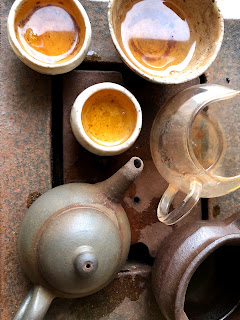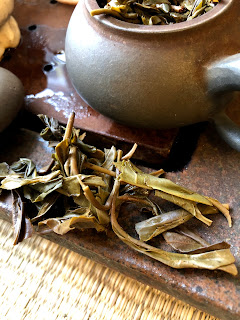In a bout of bad luck last year, I both broke my dailyyixing teapot and had a sellout of a puerh at time of checkout!
Wilson (Adventure in Every Cup) turned my bad luck into good by remedying both of
these issues! First he helped me find
this beautiful old factoy 1 early 90s/late 80s yixing 200ml teapot (pictured in this post). Scondly, he sent me a bit of a treat, a
sample of this 2008 Dayi Qui Xiang ($85.00 for 500g cake or $0.17/g) - the one that sold out on me at Tuo Cha Tea! If you are into 10 years factory puerh, its
worth checking out Willson’s interesting selection of good drinkers.
There are many many reasons that I had reservations about
purchasing this dry stored option at good ol’ Tuo Cha Tea. First, I had to get over the fact it is an autumnal produced puerh. This 2008 Day hardly resembles autumnal material to
me and will challenge your assumptions about the nature of autumn puerh. The second reservation I had is, like
most factory options, there is usually a lot of it out there with a multitude
of storage options and availability online.
This makes for a hard choice if you are looking to buy in volume. For me I almost want to try
it in different storage conditions before deciding on purchase. Often, if there is a deal to be had, you have
to act quick in the face of rising prices.
The crazy cheap option at Tuo Cha Tea that I just couldn’t
complete was the least optimal storage for this cake, I think. I have bought some of Menghai factory
stuff before that pretty much requires/ was really only meant for more humid storage and am currently dosing them with heavy humidity. Not all Menghai Factory (Daiyi) requires such
humid storage but most of it isn’t meant for overly dry storage. This is one of the reasons I have not owned
any Dayi in the past. This 2008 Dayi QuiXiang is so strong that it really does need many more years of humid storage before it is consumed. It’s more of a
long term buy. I always have a hard time
going down this road due to past advice to just avoid it and buy something that
can be enjoyed in some way at time of purchase.
The previous samplings I’ve done with this tea, it kicked
the crap out of me so this time I use less leaf! This infusion I’m using ½ to 1/3 less leaf as
I usually do… Let’s see what this Maylaysian stored one is all about…
The dry leaves smell of faint rum, plumb and wheat grains
and decaying flowers.
The first infusion has a slight sweet, slightly decomposing leaf
taste to it with a long cooling mouthfeel and subtle spicy finish. There is a nice sticky mouthfeeling distant
smoke.
The second infusion has a nice thick rose and wood powdery
taste with a nice floral sweet backbone in a more typical Menghai factory feel. There is a long sweet finish a sticky
mouthfeel. Retuning menthol. The qi is strong and alerting in the mind, I
can feel the intensity behind my eyes and in my stomach.
The third gives me a mild itch sensation but flavors are
strong, thick and deep. Layered woods,
slight talc rose, sweet floral, plumb, and sweet potato layered sweetness. The mouthfeel is dense and the finish is
camphorus, slight floral, sweet. The qi
is quite intense, very strongly alerting, it still beats up the stomach pretty
good.
The fourth infusion has a leafier, woody layering to it with
sweetness and talc rose floral on the edges.
The long menthol finish is nice. Sweetness
pops slightly in the long cooling aftertaste.
The fifth infusion is of woods immediately with sweetness
lingering in the distance that stretches its legs in the aftertaste along with
menthol like tastes. In the aftertaste
there are faint suggestions of tropical fruits under floral talc tastes and
fruity nuances. The menthol finish is
strong and the monthfeel is dense. The
mid throat opens under the threat of abundant menthol. The Qi black logs in the head and mind and
makes me feel like I am levitating a bit.
Strong Qi but a bit too harsh on the stomach, needs to age at least
another 5 years.
The sixth and seventh infusions are much the same rose talc,
woods, sweetness, thick mouthfeeling, strong qi. Long menthol.
This tea stays pretty consistent from infusion to infusion but is deep
and enjoyable.
The seventh infusion has a nice mellow woody start, the
action is in the aftertaste with long champor and tight aged florals.
The eighth and ninth infusions becomes very smooth, velvety
wood and plum with leathery tastes. The
aftertaste is forever cooling. Mouthfeel
is not as strong but present.
The tenth infusion I add 10 seconds to the flash infusion which
seems to bring a bit of a thicker mouthfeeling and more of a nuanced initial
taste of woods and talc sweetnesses. The
menthol becomes more pronounced but it is not harsher.
The eleventh infusion I add 15 seconds to flash and get a
slightly more rough infusion with a mouthfeel that has a drier astringent edge with
mainly woody character now with there is a noticeable smokiness now that has
gone from being more background to more upfront with the increase dry astringency.
With the 200ml pot and rougher profile, I toss in the towel
with this tea early.
This tea is flavorful, has a nice mouthfeel,
aftertaste, and powerful qi. It is economical
in the sense that you need about ½-1/3 less leaves to get a strong flavor and
that it is a 500g cake ($0.17/g). It tastes to me
like it may have both Menghai and Nannou blended in there. Reminds me in many
ways of this older and cheaper but harsher 2005 CNNP Big Yellow Mark but
this Menghai Factory option is much cleaner, no smokey mesquite, and has some
charms of typical Dayi factory deliciousness.
I would love to see someone who thought they could get away
with just using a gaiwan attempt to enjoy this strong tea. I’m happy I have this pot to curb the
harshness, it seems to do a great job at reducing the difficult edges of the
2007 Yang Qing Hao Qi Zhong that I have been most frequently stepping in
this pot as of late.
Really this 2008 Qui Xiang needs at least another 5 years to
be enjoyed as aged pureh. I
think people in the West are just beginning to understand how to age these stronger
factory things out.
In the end, this has got to be one my favorite 2008 Menghai
Factory puerh but I’m unsure about a purchase and almost would like to try a
few more different storage options before settling on this cake. Thanks again Wilson for helping to lift me
through my streak of mishappenings! So
far, this cake has the best storage I’ve seen on it.
Peace















